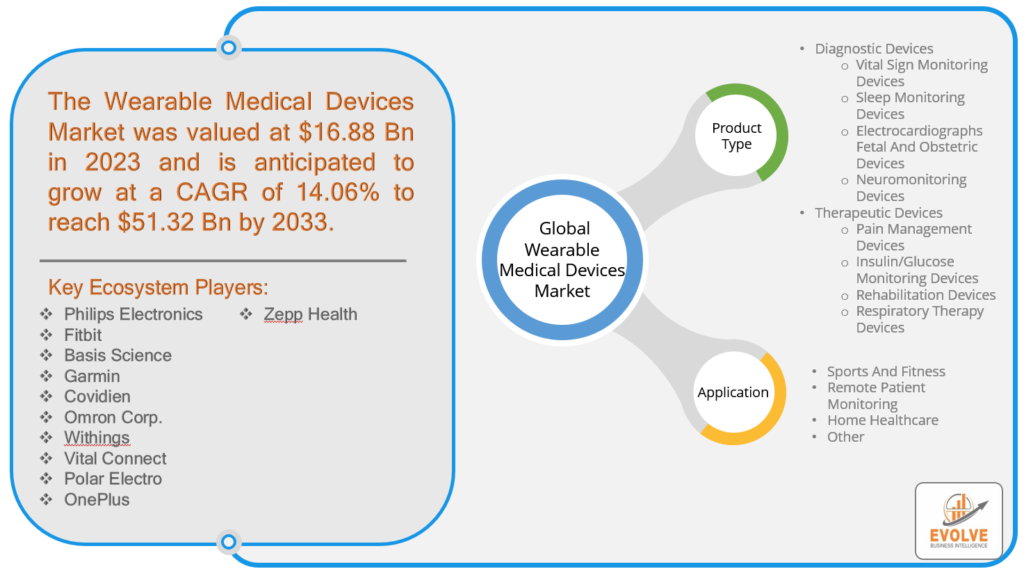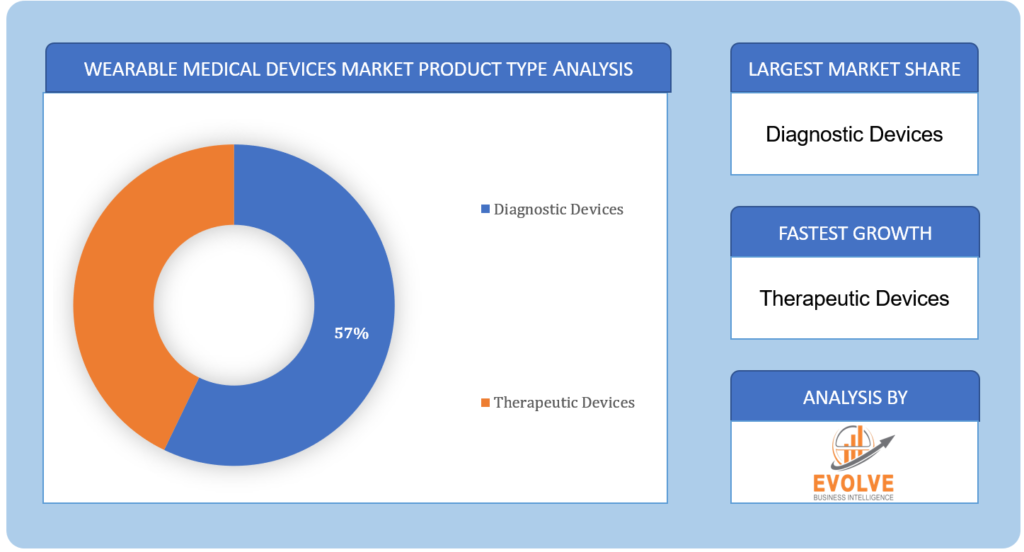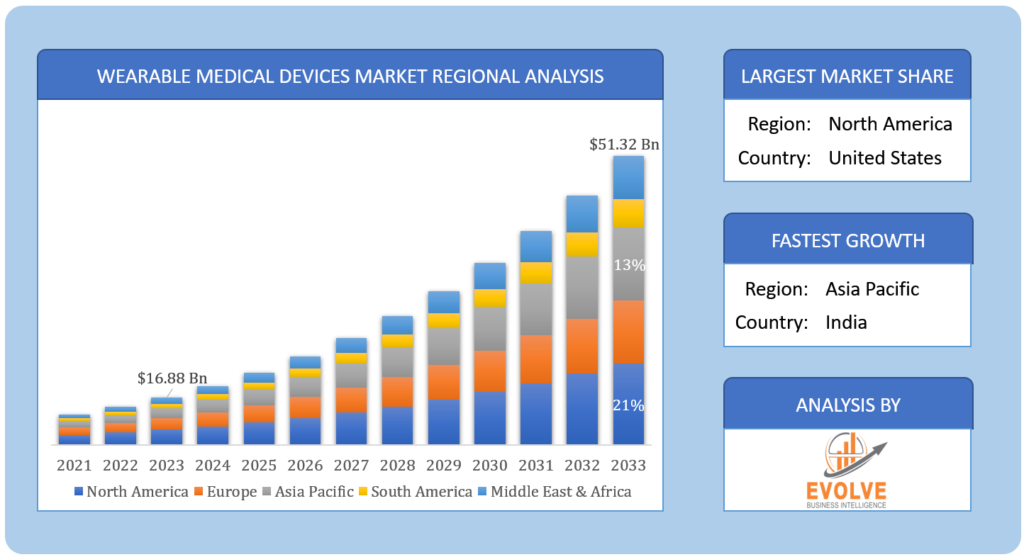Wearable Medical Devices Market Overview
Wearable Medical Devices Market Size is expected to reach USD 51.32 Billion by 2033. The Wearable Medical Devices industry size accounted for USD 16.88Billion in 2023 and is expected to expand at a compound annual growth rate (CAGR) of 14.06% from 2023 to 2033.Wearable medical devices are electronic devices designed to be worn on the body, commonly around the chest or wrist, that can monitor and record various health parameters such as heart rate, blood pressure, temperature, activity levels, and sleep patterns. Equipped with sensors, these devices can capture health data and transmit it wirelessly to smartphones, tablets, or other compatible devices for analysis and monitoring. In addition, they can send alerts and notifications to the wearer and healthcare provider, enabling real-time tracking of vital signs and other health metrics. By utilizing wearable medical devices, it is possible to improve patient outcomes, facilitate remote monitoring, and gain valuable insights into the overall health status of the individual wearing the device.
 COVID-19 Impact Analysis and Post-COVID Scenario
COVID-19 Impact Analysis and Post-COVID Scenario
The COVID-19 pandemic had a positive impact on the Wearable Medical Devices market. The pandemic has led to an increased demand for remote monitoring of patient’s health, particularly those with chronic conditions, to reduce hospital visits and the risk of exposure to the virus. Wearable medical devices provide a convenient and cost-effective means of monitoring patients remotely, allowing healthcare providers to track vital signs and other health metrics in realtime. Additionally, the pandemic has fostered an increased focus on personal health and wellness, as well as the adoption of telehealth and virtual care services. Wearable medical devices can play a vital role in supporting these trends, enabling patients to monitor their health and communicate with their healthcare providers from the comfort of their own homes. Furthermore, the pandemic has heightened awareness of the importance of public health, leading to increased adoption of wearable medical devices by individuals and healthcare providers alike. Consequently, the wearable medical devices market is anticipated to continue growing in the coming years.
Global Wearable Medical Devices Market Growth Factors
- Growing focus on personal health and wellness
The growing consumer interest in personal health and wellness has contributed to an increased demand for wearable devices that can monitor and track their health and fitness levels. This trend is driven by a desire for individuals to take a more proactive approach to their health and well-being and an increased awareness of the benefits of regular physical activity and healthy lifestyle choices. Wearable medical devices can provide users with real-time data on various health parameters, such as heart rate, blood pressure, and activity levels, which can help individuals make informed decisions about their health and lifestyle. Additionally, wearable devices that incorporate fitness tracking features are becoming increasingly popular, as they allow users to monitor their physical activity and set goals to improve their overall fitness levels.
Global Wearable Medical Devices Market Restraining Factors
- Privacy and security concerns
Wearable medical devices can collect and transmit sensitive health data, such as heart rate, blood pressure, activity levels, and sleep patterns. As this data is personal and sensitive, there are growing concerns about privacy and security issues related to the use of these devices. Patients who use wearable medical devices may have reservations about using them if they are unsure about the protection of their data from unauthorized access or misuse. This can lead to a reluctance to adopt these devices, which can have a negative impact on the growth of the Wearable Medical Devices market.
Global Wearable Medical Devices Market Opportunity Analysis
- The increasing focus on personalized medicine
The growing focus on personalized medicine presents a significant opportunity for the wearable medical devices market. Wearable devices can collect a wealth of data on an individual’s health and leverage artificial intelligence and machine learning technologies to identify patterns and provide personalized recommendations for improving health outcomes. By tailoring medical interventions to individual patients, wearable medical devices have the potential to significantly improve patient outcomes and reduce healthcare costs. Additionally, as healthcare systems move towards value-based care models that prioritize patient outcomes over the volume of services provided, wearable medical devices can play a crucial role in delivering personalized, cost-effective care.
Global Wearable Medical Devices Market Segment Analysis
 The diagnostic devices segment is expected to hold the largest market share in 2023
The diagnostic devices segment is expected to hold the largest market share in 2023
Based on the Product Type, the Wearable Medical Devices market is segmented based on Diagnostic Devices {Vital Sign Monitoring Devices, Sleep Monitoring Devices, Electrocardiographs Fetal And Obstetric Devices, Neuromonitoring Devices}, Therapeutic Devices {Pain Management Devices, Insulin/Glucose Monitoring Devices, Rehabilitation Devices, Respiratory Therapy Devices}. The Diagnostic Devices segment is anticipated to hold the largest market share in the Wearable Medical Devices market due to their ability to monitor and diagnose various medical conditions, including cardiovascular diseases, sleep disorders, and diabetes. These devices can collect data such as heart rate, blood pressure, glucose levels, and respiratory rate, which can then be analyzed to provide insights into a patient’s health status. With advancements in sensor technology and data analytics, diagnostic wearable medical devices are becoming increasingly accurate and reliable, leading to a growing demand for these devices in both clinical and home settings.
The home health care segment is expected to hold the largest market share in 2023
Based on Application, the global Wearable Medical Devices market has been divided into Sports And Fitness, Remote Patient Monitoring, Home Healthcare, and Others.The home healthcare segment is anticipated to be the major contributor to the wearable medical devices market. The surge in demand for remote patient monitoring and the growing preference for home-based healthcare services are the primary drivers of this trend. Wearable medical devices offer a convenient and cost-efficient way to remotely monitor patient health, eliminating the requirement for hospital visits and leading to better patient outcomes.
Global Wearable Medical Devices Market, Segmental Chart
 Wearable Medical Devices Market Regional Analysis
Wearable Medical Devices Market Regional Analysis
Based on region, the global Wearable Medical Devices market has been divided into North America, Europe, Asia-Pacific, theMiddle East & Africa, and Latin America. The market for wearable medical devices is anticipated to be dominated by North America, followed by the Asia-Pacific and European regions.
Regional Coverage:
- North America
- US
- Canada
- Mexico
- Europe
- UK
- Germany
- France
- Italy
- Spain
- Benelux
- Russia
- Rest of Europe
- Asia Pacific
- China
- Japan
- South Korea
- Indonesia
- Australia
- Malaysia
- Thailand
- India
- Rest of Asia Pacific
- Latin America
- Brazil
- Argentina
- Rest of Latin America
- Middle East & Africa
- Saudi Arabia
- UAE
- Egypt
- South Africa
- Rest of Middle East & Africa
North America Market
North America has a robust healthcare system with advanced technological infrastructure, which has led to high levels of technological innovation in the healthcare industry. This, coupled with the increasing healthcare expenditure in the region, has made North America the largest market for wearable medical devices. The favorable government policies, such as the Affordable Care Act in the US, have also contributed to the growth of the wearable medical devices market in North America. Additionally, the presence of major players in the region, such as Fitbit, Apple, and Garmin, has further boosted the growth of the market. These companies have developed innovative wearable medical devices that are highly sought after by consumers in the region. The increasing prevalence of chronic diseases, such as diabetes and heart disease, in North America, has also led to a growing demand for wearable medical devices that can monitor and track vital signs and health metrics in realtime. All these factors have contributed to the dominance of North America in the wearable medical devices market.
Asia Pacific Market
The Asia Pacific region has exhibited the largest CAGR in the Wearable Medical Devices market. This growth is mainly driven by the presence of a large population base, the rising prevalence of chronic diseases, increasing healthcare spending, and growing awareness and adoption of wearable medical devices. In addition, government initiatives to promote the use of digital health technologies, increasing investments by market players in the region, and the development of advanced healthcare infrastructure are expected to further boost the growth of the Wearable Medical Devices market in the Asia-Pacific region.
Competitive Landscape
The competitive landscape includes key players (tier 1, tier 2, and local) having a presence across the globeCompanies such as Garmin, Covidien, Omron Corp, and OnePlusare some of the leading players in the global Wearable Medical Devices market. These players have adopted partnership, acquisition, expansion, and new product development, among others as their key strategies.
Key Market Players:
- Philips Electronics
- Fitbit
- Basis Science
- Garmin
- Covidien
- Omron Corp
- Withings
- Vital Connect
- Polar Electro
- OnePlus
- Zepp Health
Market Share Acquisition Strategies: Analysis of Key Approaches Employed by Top Players
On November 2022, Zepp Health announced the launch of the Amazfit Pop 2, a smartwatch available only in India. The e-commerce website Flipkart sells fitness wearables.
On October 2022, OnePlus has announced the release of the OnePlus Nord watches wearable gadget. Step counts, calories burnt, and sleep quality data are measured and stored by the OnePlus Nord Watch when it is connected to a smartphone running the N Health app.
Report Scope:
Global Wearable Medical Devices Market, by Product Type
- Diagnostic Devices
- Vital Sign Monitoring Devices
- Sleep Monitoring Devices
- Electrocardiographs Fetal And Obstetric Devices
- Neuromonitoring Devices
- Therapeutic Devices
- Pain Management Devices
- Insulin/Glucose Monitoring Devices
- Rehabilitation Devices
- Respiratory Therapy Devices
Global Wearable Medical Devices Market, by Application
- Sports And Fitness
- Remote Patient Monitoring
- Home Healthcare
- Other
Global Wearable Medical Devices Market Synopsis:
| PARAMETER | VALUE |
Market Size |
· 2023: USD 16.88Billion· 2033: USD 51.32Billion |
Growth Rate |
· First 5 Years CAGR (2023–2028): XX%· Last 5 Years CAGR (2028–2033): XX%· 10 Years CAGR (2023–2033): 14.06% |
Key Market Drivers |
· Increasing prevalence of chronic diseases· Favorable government policies |
Key Market Restraints |
· Lack of regulatory standards· Privacy and security concerns |
Market Opportunities |
· The increasing focus on personalized medicine· The rise in consumer interest in health and wellness |
Key Market Players |
· Philips Electronics· Fitbit· Basis Science· Garmin· Covidien· Omron Corp.· Withings· Vital Connect· Polar Electro· OnePlus· Zepp Health |
REPORT CONTENT BRIEF:
- High-level analysis of the current and future Wearable Medical Devices market trends and opportunities
- Detailed analysis of current market drivers, restraining factors, and opportunities analysis in the future
- Historical market size for the year 2022, and forecast from 2023 to 2033
- Wearable Medical Devices market share analysis for each segment
- Competitor analysis with a comprehensive insight into its product segment, financial strength, and strategies adopted.
- Identifies key strategies adopted by the key players including new product development, mergers and acquisitions, joint ventures, collaborations, and partnerships.
- To identify and understand the various factors involved in the global Wearable Medical Devices market affected by the pandemic
- To provide year-on-year growth from 2022 to 2033
- To provide short-term, long-term, and overall CAGR comparisons from 2021 to 2033.
- Provide Total Addressable Market (TAM) for the Global Wearable Medical Devices Market
Frequently Asked Questions (FAQ)
What are the 10 Years CAGR (2023 to 2033) of the global Wearable Medical Devices market?
The global Wearable Medical Devices market is growing at a CAGR of ~06% over the next 10 years
Which region has the highest growth rate in the global Wearable Medical Devices market?
Asia Pacific is expected to register the highest CAGR during 2023-2033
Which region accounted for the largest share of the global Wearable Medical Devices market?
North America holds the largest share in 2022
Major Key Players in the Global Wearable Medical Devices Market?
Philips Electronics, Fitbit, Basis Science, Garmin, Covidien, Omron Corp, Withings, Vital Connect, Polar Electro, OnePlus, and Zepp Healthare the major companies operating in the global Wearable Medical Devices
Do you offer Post Sale Support?
Yes, we offer 16 hours of analyst support to solve the queries
Do you deliver sections of a report?
Yes, we do provide regional as well as country-level reports. Other than this we also provide a sectional report. Please get in contact with our sales representatives.






